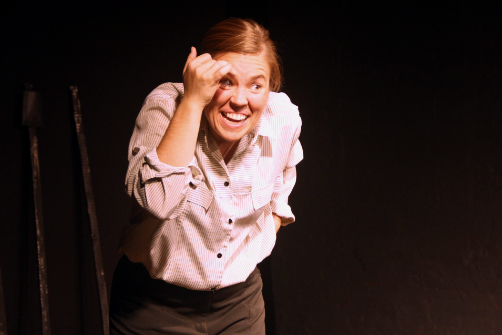The Glowing Boot
Written and Performed by Alice Pencavel; DIrected by Paul Bedard
Part of the United Solo Festival
Off Off Broadway, Solo Show
Runs through 10.18.16
The Studio Theatre at Theatre Row, 410 West 42nd Street
by Ran Xia on 10.19.16
 Alice Pencavel in The Glowing Boot. Photo by Eva Preskin.
Alice Pencavel in The Glowing Boot. Photo by Eva Preskin.
BOTTOM LINE: A woman's journey of self discovery through solving a fantastical mystery from the past.
An empty stage. Then a woman enters carrying with her a little stool, strapped with a bundle of wood. She tentatively starts to tell the story of her life:
The nameless narrator, who has always struggled with her sense of self, receives a strange request for help from one Sir Barnaby Orion, after the sudden and tragic passing of her lover Clementine from a snakebite. Thus the narrator sets out into the woods, embarking on a journey to solve a mystery from the past, specifically the late nineteenth century. The narrator soon discovers Orion's cabin by a dark lake, in the midst of which is a glowing boot. Retrieves the boot she does, and finds that the object is indeed a horcrux of Sir Barnaby Orion, a hermit aristocrat, whose tortured soul is bound to the boot. Hence the ghost of Orion appears, sending the narrator on a peculiar scavenger hunt, in order to release Orion's soul from the curse that binds him.
Like on any hero's journey, the narrator's process of fulfilling the tasks entrusted to her is filled with metaphors and symbolism: an old man who reaps the seeds from boys' hearts; an ivy wreath bound with sap; a deer with thumbs, among other extraordinary encounters. During her search, the narrator stumbles upon Orion's diary, which unravels the subplot of the play: Orion's history with the goddess Artemis. It is only then gradually revealed to the audience that Sir Orion is indeed a version of the legendary huntsman. In this version, Orion became infatuated with Artemis' twin brother Apollo, to her dismay. As the narrator contemplates Orion's story, she relives her past with Clementine, her dearly departed partner. By releasing Orion's cursed soul, the narrator is able to find her identity as well. Her struggles with her sexual orientation, accompanied by trials and tribulations in the past, are finally lifted away from her shoulders like a heavy weight.
Alice Pencavel's writing is whimsical and dynamic. The play is partly in verse, and its inherent rhythms propel the story forward and continuously seduce the audience to follow the hero's adventure. The style of the narrative reminds one of a Neil Gaiman or Daphne Du Maurier novel: the source material is ancient and grand, and with it, the playwright constructs a deeply personal and thoroughly modern tale about the hero's love, loss, and a self discovery. As a performer, Pencavel's embodiment of the various characters in the tale is to be applauded. Director Paul Bedard's staging also enhances the clarity of the tale: the audience would surely be impressed with the level of complexity in this solo piece, yet still be able to follow the story with ease.
Last but not least, the design team does an excellent job creating a magical environment mixed with the modern world, the enchanted forest where Greek gods and English aristocrats reside. Dan Daly creates a movable set that benefits the repertory nature of a festival show: the planks of wood the narrator brings onto the stage are placed around the stage to transform the space into a small cabin. Critical props are placed atop each plank, a smart device to establish the environment. Philip Gerson's sound design brings the magic of the piece to the next level in creating a sound profile for many of the characters: for example, the presence of Apollo is accompanied by overwhelming electric guitar solos, appropriately depicting the grandiosity of the sun god. The narrator's Hamlet moments with the ghost of Orion are some of the most dramatic and memorable parts of the show: with only a torchlight illuminating her, Pencavel manipulates the torch to drop huge shadows of her hand onto the walls, creating the threatening presence of Orion's ghost. Claire Moodey's underwater lighting when the narrator retrieves the boot from the lake is another noteworthy moment of theatre magic.
(The Glowing Boot played at The Studio Theatre at Theatre Row, 410 West 42nd Street, through October 18, 2016. The running time was one hour and ten minutes without an intermission. Performances were Monday 10/17 and Tuesday 10/18 at 9. Tickets were $20.25. For more information visit unitedsolo.org.)
The Glowing Boot is written and performed by Alice Pencavel. Directed by Paul Bedard. Set Design is by Dan Daly. Conceptual Design is by Claire Moodey. Sound Design is by Philip Gerson. Costume Design is by Nicole Slavin. Dramaturg is Eva Peskin. Stage Manager is Emily Roth.

